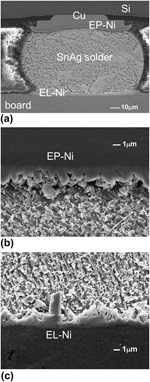Crossref Citations
This article has been cited by the following publications. This list is generated based on data provided by
Crossref.
Ricciari, R.
Ferlito, E.P.
Pizzo, G.
Padalino, M.
Anastasi, G.
Sacchi, M.
Pappalardo, G.
Consalvo, C.
and
Mello, D.
2015.
Auger electron spectroscopy characterization of Ti/NiV/Ag multilayer back-metal for monitoring of Ni migration on Ag surface.
Microelectronics Reliability,
Vol. 55,
Issue. 9-10,
p.
1617.
Lis, Adrian
Kenel, Christoph
and
Leinenbach, Christian
2016.
Characteristics of Reactive Ni3Sn4 Formation and Growth in Ni-Sn Interlayer Systems.
Metallurgical and Materials Transactions A,
Vol. 47,
Issue. 6,
p.
2596.
Lee, Chang-Chun
Huang, Pei-Chen
and
Chian, Bow-Tsin
2016.
Development and demonstration of equivalent material characteristics for microbump arrays utilized in failure estimation of chip-on-chip packaging.
p.
262.
Zhang, Hao
Nagao, Shijo
Kurosaka, Seigo
Fujita, Hiroshi
Yamamura, Keiji
Shimoyama, Akio
Seki, Shinya
Sugahara, Tohru
and
Suganuma, Katsuaki
2016.
Thermostable electroless plating optimized for Ag sinter die-attach realizing high T<inf>J</inf> device packaging.
p.
1.
Wendt, Mathias
Plöβl, Andreas
Weimar, Andreas
Zenger, Marcus
and
Dilger, Klaus
2016.
Investigation of the Influence of Annealing Temperature on the Morphology and Growth Kinetic of Ni3Sn4 in the Ni-Sn-Solder System.
Journal of Materials Science and Chemical Engineering,
Vol. 04,
Issue. 02,
p.
116.
Chen, Ming-Yao
Liang, Y. C.
and
Chen, Chih
2016.
Electromigration in reduced-height solder joints with Cu pillars.
Journal of Materials Science: Materials in Electronics,
Vol. 27,
Issue. 4,
p.
3715.
Min, Kyung Deuk
Jung, Kwang-Ho
Lee, Choong-Jae
Jeong, Haksan
Hwang, Byeong-Uk
and
Jung, Seung-Boo
2020.
Transient Liquid Phase Sintering of Ni and Sn-58Bi on Microstructures and Mechanical Properties for Ni–Ni Bonding.
Electronic Materials Letters,
Vol. 16,
Issue. 4,
p.
347.
Sohn, Yoonchul
2020.
Effect of Morphological Change of Ni3Sn4 Intermetallic Compounds on the Growth Kinetics in Electroless Ni-P/Sn-3.5Ag Solder Joint.
Metallurgical and Materials Transactions A,
Vol. 51,
Issue. 6,
p.
2905.
Huang, Yan-Rong
Tran, Dinh-Phuc
Hsu, Po-Ning
Yang, Shih-Chi
Gusak, A.M.
Tu, K.N.
and
Chen, Chih
2023.
To suppress thermomigration of Cu–Sn intermetallic compounds in flip-chip solder joints.
Journal of Materials Research and Technology,
Vol. 24,
Issue. ,
p.
7910.
Wang, Chengqian
Luo, Keyu
He, Peng
Zhou, Hongzhi
Li, Rongqing
Zhang, Zhihao
Yu, Daquan
and
Zhang, Shuye
2023.
Quasi in-situ observation of Ni-plated solder from various fracture mechanism using EBSD.
Journal of Materials Research and Technology,
Vol. 24,
Issue. ,
p.
1875.
Amli, Siti Farahnabilah Muhd
Salleh, Mohd Arif Anuar Mohd
Aziz, Mohd Sharizal Abdul
Yasuda, Hideyuki
Nogita, Kazuhiro
Abdullah, Mohd Mustafa Al Bakri
Nemes, Ovidiu
Sandu, Andrei Victor
and
Vizureanu, Petrica
2023.
Effects of Multiple Reflow on the Formation of Primary Crystals in Sn-3.5Ag and Solder Joint Strength: Experimental and Finite Element Analysis.
Materials,
Vol. 16,
Issue. 12,
p.
4360.
Li, Xiaofu
Xing, Jing
Chen, Xiangxu
Yao, Jinye
and
Ma, Haitao
2023.
Effect of Cu content in the Ni-Cu under-bump metallurgy on the interfacial reaction between Ni1-xCux and Sn solder.
p.
1.
Yao, Jinye
Wang, Li
Guo, Shihao
Li, Xiaofu
Chen, Xiangxu
Shang, Min
Ma, Haoran
and
Ma, Haitao
2024.
First-Principles Study of Cu Addition on Mechanical Properties of Ni3Sn4-Based Intermetallic Compounds.
Metals,
Vol. 14,
Issue. 1,
p.
64.



